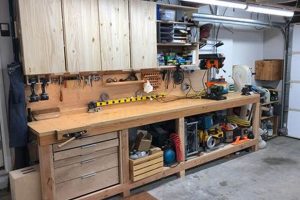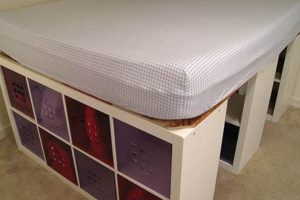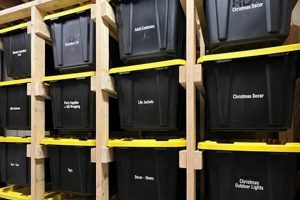The construction of custom organizational solutions for photographic lighting equipment addresses a common challenge faced by photographers and videographers: managing and protecting bulky and often delicate light stands. These bespoke systems range from simple, repurposed containers to more elaborate, purpose-built structures designed to maximize space efficiency and ensure the longevity of the equipment.
Effective equipment management offers several tangible benefits, including reduced risk of damage during storage and transport, improved accessibility to necessary tools on set, and a more organized studio or workspace. Historically, professionals have relied on commercially available solutions, which can be expensive and not always tailored to specific needs. This has led to a growing interest in alternative, individualized approaches that leverage readily available materials and basic construction techniques.
Subsequent sections will explore various construction approaches, material selections, and design considerations relevant to creating tailored organization for lighting supports. Specific examples, safety precautions, and cost-effectiveness evaluations will be discussed to provide a comprehensive understanding of implementing such systems.
Optimizing Photographic Lighting Support Organization
The following recommendations are intended to improve the efficiency and effectiveness of custom-built organizational systems for photographic lighting supports. Careful consideration of these points will contribute to enhanced equipment protection and accessibility.
Tip 1: Material Selection. Employ durable materials such as plywood, heavy-duty plastics, or reinforced metal to ensure the structure’s ability to withstand the weight and potential impact of the stored light stands. Avoid materials prone to warping or degradation under varying environmental conditions.
Tip 2: Space Assessment. Conduct a precise measurement of the available storage area before commencing construction. Account for both the footprint of the system and the vertical space required to accommodate light stands of varying lengths, including those in their collapsed and extended states.
Tip 3: Customization for Stand Types. Design separate compartments or securing mechanisms to accommodate different types of lighting supports, such as tripod-based stands, C-stands, and boom stands. This minimizes the risk of entanglement and facilitates rapid retrieval of specific equipment.
Tip 4: Protective Padding. Integrate padding or cushioning within the storage structure to prevent scratches, dents, and other forms of physical damage to the lighting supports during storage and transport. Closed-cell foam or felt lining are suitable options.
Tip 5: Mobility Considerations. Incorporate casters or wheels into the design if the organizational system needs to be easily moved. Ensure the casters are load-rated to support the combined weight of the structure and the stored equipment. Locking casters are recommended to prevent unintended movement.
Tip 6: Secure Fastening. Implement secure fastening mechanisms, such as straps, clips, or bungees, to prevent the light stands from shifting or falling out of their designated compartments, particularly during transport. Ensure these mechanisms are readily accessible and easy to operate.
Tip 7: Labeling and Identification. Clearly label each compartment or section of the storage system to identify the type and size of light stand stored within. This facilitates efficient equipment retrieval and reduces the time spent searching for specific items.
Adherence to these principles contributes to a safer, more organized, and ultimately more productive photographic or videographic workflow. Prioritizing durability, customization, and ease of access results in a system that protects valuable equipment and streamlines on-set operations.
The following sections will provide practical construction guidance, including detailed plans and material lists for various organization systems.
1. Material Durability
The longevity and protective capacity of custom-built organizational systems for photographic lighting supports are directly contingent upon the selection of durable materials. The inherent weight and potential for impact associated with light stands necessitate the utilization of robust materials capable of withstanding repeated stress and environmental factors. Insufficient material strength leads to premature degradation of the storage solution, potentially resulting in equipment damage and increased replacement costs. For example, a storage rack constructed from thin particleboard may buckle under the weight of multiple light stands, whereas a similar structure fabricated from steel or reinforced plywood offers greater resistance and extended service life.
Material durability extends beyond simple load-bearing capacity. Resistance to moisture, temperature fluctuations, and physical abrasion are equally critical considerations. A storage system intended for use in a humid environment, such as an outdoor shooting location, should be constructed from materials that resist corrosion and warping. Similarly, materials with smooth, non-abrasive surfaces minimize the risk of scratching or damaging the light stands during storage and retrieval. The choice of fasteners, such as screws and bolts, also contributes to the overall durability of the system; corrosion-resistant hardware is essential for preventing structural weakening over time.
In summary, prioritizing material durability in the design and construction of storage for photographic lighting supports is a fundamental investment in the long-term protection of valuable equipment. Neglecting this aspect undermines the intended purpose of the organization system, ultimately leading to increased equipment maintenance or replacement expenses. Careful selection of materials that offer both structural integrity and resistance to environmental factors is essential for ensuring the sustained effectiveness of these organizational solutions.
2. Spatial Optimization
Spatial optimization, in the context of crafting bespoke organizational solutions for photographic lighting supports, refers to the strategic arrangement and efficient utilization of available storage space. This is a critical design consideration, directly impacting accessibility, equipment protection, and overall workspace efficiency.
- Vertical Space Utilization
Maximizing vertical space is essential when square footage is limited. Custom-built storage systems can extend upwards, using wall-mounted racks or multi-tiered shelves to accommodate light stands of varying heights. This approach minimizes the footprint of the storage solution and frees up floor space for other activities. For example, tall, narrow racks can be constructed to fit within unused corner spaces.
- Adjustable Configuration
The ability to reconfigure storage compartments is advantageous, accommodating changes in equipment inventory or organizational needs. Adjustable shelves, removable dividers, and modular components allow the storage system to adapt to different light stand sizes and types. This flexibility prevents wasted space and ensures that the storage solution remains relevant over time. As a specific instance, adjustable pegs or brackets can support variable stand lengths.
- Density and Proximity Planning
Careful planning of storage density ensures equipment is stored securely without sacrificing accessibility. Light stands should be arranged in a manner that prevents entanglement and allows for rapid retrieval of specific items. Strategic placement of frequently used stands in easily accessible locations minimizes workflow interruptions. For example, stands employed in nearly every shoot can be stationed at the front, while more specialized supports can be kept towards the rear.
- Minimizing Wasted Space
Efficient organization eliminates superfluous gaps between stored items, as well as poorly planned storage configurations. The storage arrangement should be such that there is no space between light stands which are of different sizes. For example, taller ones could be placed close by shorter ones with empty spaces in between to be filled with more short sizes stands.
Effective spatial optimization is not merely about maximizing the quantity of equipment that can be stored, but about creating an intuitive and efficient workflow. By carefully considering the dimensions of the available space, the types of light stands being stored, and the frequency with which they are used, it is possible to design custom organization solutions that significantly enhance productivity and protect valuable equipment. Failing to address this topic, increases work hours and reduces the lifespan of the equipments.
3. Stand Compatibility
The principle of stand compatibility is paramount in the planning and execution of custom photographic lighting support organization. The physical dimensions, weight capacity, and specific features of various light stand models necessitate tailored storage solutions to prevent damage and ensure ease of access. A universal storage approach, neglecting the nuanced requirements of individual stand types, invites inefficiency and potential equipment failure. For instance, attempting to store a heavy-duty C-stand within a compartment designed for a lightweight tripod stand may result in structural compromise of the storage unit or damage to the C-stand itself. Therefore, a successful organizational system must account for the diverse characteristics of the equipment it houses.
Implementing stand compatibility in organizational projects involves a multi-faceted approach. Initially, a comprehensive inventory of all lighting supports should be conducted, documenting their dimensions, weight, and unique features, such as locking mechanisms or adjustable arms. This information then informs the design of custom compartments or securing mechanisms tailored to each stand type. For example, a dedicated slot with reinforced support might be created for a heavy C-stand, while a series of padded dividers could be used to separate and protect lightweight tripod stands. Furthermore, consideration should be given to the collapsed and extended lengths of the stands, ensuring that the storage system can accommodate them in both configurations. The choice of materials must also align with the weight and potential abrasiveness of the stands being stored. Abrasive materials can damage the surface finishes of stands during storage and retrieval. The goal is to create a “safe fit” rather than just jamming equipment in.
In conclusion, stand compatibility is not merely a desirable attribute but a fundamental requirement for effective storage of photographic lighting supports. By carefully assessing the characteristics of individual stands and designing custom storage solutions that address their specific needs, photographers and videographers can significantly reduce the risk of equipment damage, improve workflow efficiency, and extend the lifespan of their valuable tools. Neglecting this crucial aspect undermines the overall effectiveness of the storage system and increases the likelihood of costly repairs or replacements.
4. Accessibility
Accessibility, in the context of self-constructed organizational systems for photographic lighting supports, represents a critical factor determining workflow efficiency and overall usability. A well-designed system prioritizes not only the secure storage of equipment but also the ease with which it can be retrieved and deployed.
- Rapid Retrieval
Efficient access to equipment directly impacts productivity on set. A custom system should facilitate rapid retrieval of specific light stands without requiring extensive rearrangement or disassembly. For example, clearly labeled compartments and unobstructed pathways minimize the time spent locating and extracting necessary equipment. The layout should be intuitive, allowing users to quickly identify and retrieve items even under time constraints.
- Ergonomic Design
The physical effort required to access and remove light stands from storage should be minimized. Heavy or bulky equipment should be stored at a convenient height to reduce the risk of strain or injury. The storage system should incorporate design elements that promote safe and comfortable handling, such as handles, ramps, or adjustable shelves. Placement of frequently used stands at waist height optimizes retrieval.
- Clear Visibility
Visual clarity of stored equipment enhances accessibility by enabling quick identification of items. Open-front compartments or transparent containers allow users to easily see the contents without needing to physically handle the stands. Adequate lighting in the storage area further improves visibility, especially in dimly lit studios or storage rooms. The utilization of contrasting colors for labeling or for stands of different types allows users to more quickly differentiate one stand from another.
- Organized Layout
A logically organized storage layout contributes significantly to accessibility. Grouping light stands by type, size, or frequency of use simplifies the retrieval process. A well-defined system prevents clutter and ensures that equipment is consistently stored in its designated location. This reduces the time spent searching for items and minimizes the risk of misplacing or damaging equipment.
By prioritizing accessibility in the design and implementation of equipment organization, photographers and videographers can streamline their workflow, reduce physical strain, and enhance overall productivity. An accessible system reduces on set frustrations.
5. Structural Integrity
The structural integrity of self-constructed storage solutions for photographic lighting supports constitutes a paramount consideration, directly influencing the safety of personnel and the protection of valuable equipment. The weight and potential instability of lighting stands, particularly when multiple units are consolidated within a storage system, necessitate a robust design capable of withstanding significant stress without deformation or collapse. Failure to adequately address structural integrity can result in catastrophic failure, leading to equipment damage, personal injury, or both. A real-world example involves a makeshift rack constructed from insufficiently rated lumber, which buckled under the combined weight of several heavy-duty C-stands, resulting in damage to the stands and posing a safety hazard to individuals nearby. The practical significance of this understanding lies in the recognition that the initial investment in appropriate materials and construction techniques mitigates the risk of future accidents and associated costs.
Achieving adequate structural integrity requires careful selection of materials, appropriate joinery techniques, and thorough load-bearing calculations. Materials should be chosen based on their inherent strength, resistance to deformation, and suitability for the intended environment. For instance, heavy-gauge steel or reinforced plywood may be preferable to thinner, less robust alternatives. Joinery techniques, such as welding, bolting, or the use of high-strength adhesives, must be employed to create secure and durable connections between structural elements. Load-bearing calculations, performed by qualified professionals or based on established engineering principles, ensure that the storage system can safely support the anticipated weight of the lighting stands. As an illustration, a wall-mounted rack requires secure anchoring to studs or reinforced backing to prevent detachment and potential collapse. Improper fastening of the rack to drywall alone, without adequate support, represents a common oversight with potentially dangerous consequences.
In summary, structural integrity is not merely a design consideration but a fundamental prerequisite for the creation of safe and reliable storage solutions for photographic lighting supports. Neglecting this aspect increases the risk of equipment damage, personal injury, and associated financial losses. By prioritizing appropriate materials, robust construction techniques, and thorough load-bearing analysis, individuals can ensure that their storage systems provide long-term protection and peace of mind. The challenge lies in understanding the specific requirements of the intended use and applying sound engineering principles to the design and construction process, leading to the safe implementation of storage and improving workplace safety.
Frequently Asked Questions
The following questions address common concerns and misconceptions regarding the design and construction of custom organizational systems for photographic lighting supports. The answers aim to provide clear and objective guidance, promoting informed decision-making.
Question 1: Is it cost-effective to construct a storage solution compared to purchasing a commercially available one?
The cost-effectiveness of a self-constructed solution depends largely on material selection, design complexity, and the availability of pre-owned materials. While commercial options offer convenience, they may not always align with specific spatial or equipment needs. A thorough cost-benefit analysis should be conducted, considering both initial expenses and long-term durability.
Question 2: What safety precautions should be observed during construction?
Adherence to standard safety protocols is essential. These include wearing appropriate personal protective equipment (PPE), such as safety glasses and gloves, when cutting or assembling materials. Power tools should be used in accordance with manufacturer instructions, and work areas should be well-ventilated to prevent the inhalation of dust or fumes.
Question 3: What type of materials is most suitable for load-bearing components?
Materials suitable for load-bearing elements include steel, reinforced plywood, and solid hardwood. The choice depends on the anticipated weight load and environmental conditions. Load-bearing calculations should be performed to ensure that the selected material possesses sufficient strength to prevent structural failure.
Question 4: How can one ensure adequate ventilation within the storage system?
Adequate ventilation is essential to prevent the accumulation of moisture, which can lead to corrosion or mold growth. Open-air designs, ventilation holes, or the use of breathable materials can promote airflow. Regular inspection for signs of moisture is recommended.
Question 5: How can one protect light stands from scratches or abrasions during storage?
Protective padding, such as closed-cell foam or felt lining, can be integrated into the storage system to prevent scratches and abrasions. Individually wrapping light stands in protective sleeves can provide an additional layer of protection.
Question 6: Is it necessary to secure light stands within the storage system?
Securing light stands is crucial, particularly during transportation or in environments prone to vibration. Straps, clips, or bungee cords can be used to prevent movement and potential damage. The securing mechanism should be easily accessible and adjustable to accommodate different stand sizes.
The above questions are a guide for building the right storage and maximizing equipment lifespan. The next section will cover detailed design layouts.
Transitioning to practical design implementations, the following segment outlines several custom storage solutions for a range of lighting equipment.
Conclusion
The preceding exploration of “diy storage for light stands” has underscored the importance of tailored organizational solutions for safeguarding and managing photographic lighting equipment. Key aspects, including material durability, spatial optimization, stand compatibility, accessibility, and structural integrity, have been identified as critical design parameters. Adherence to these principles facilitates the creation of systems that enhance workflow efficiency and minimize the risk of equipment damage.
Effective implementation requires a commitment to meticulous planning, appropriate material selection, and sound construction techniques. While commercial solutions offer convenience, bespoke designs offer the potential for superior customization and cost-effectiveness. Photographic professionals and enthusiasts are therefore encouraged to carefully evaluate their individual needs and to invest in organizational strategies that promote the longevity and accessibility of their lighting equipment.







